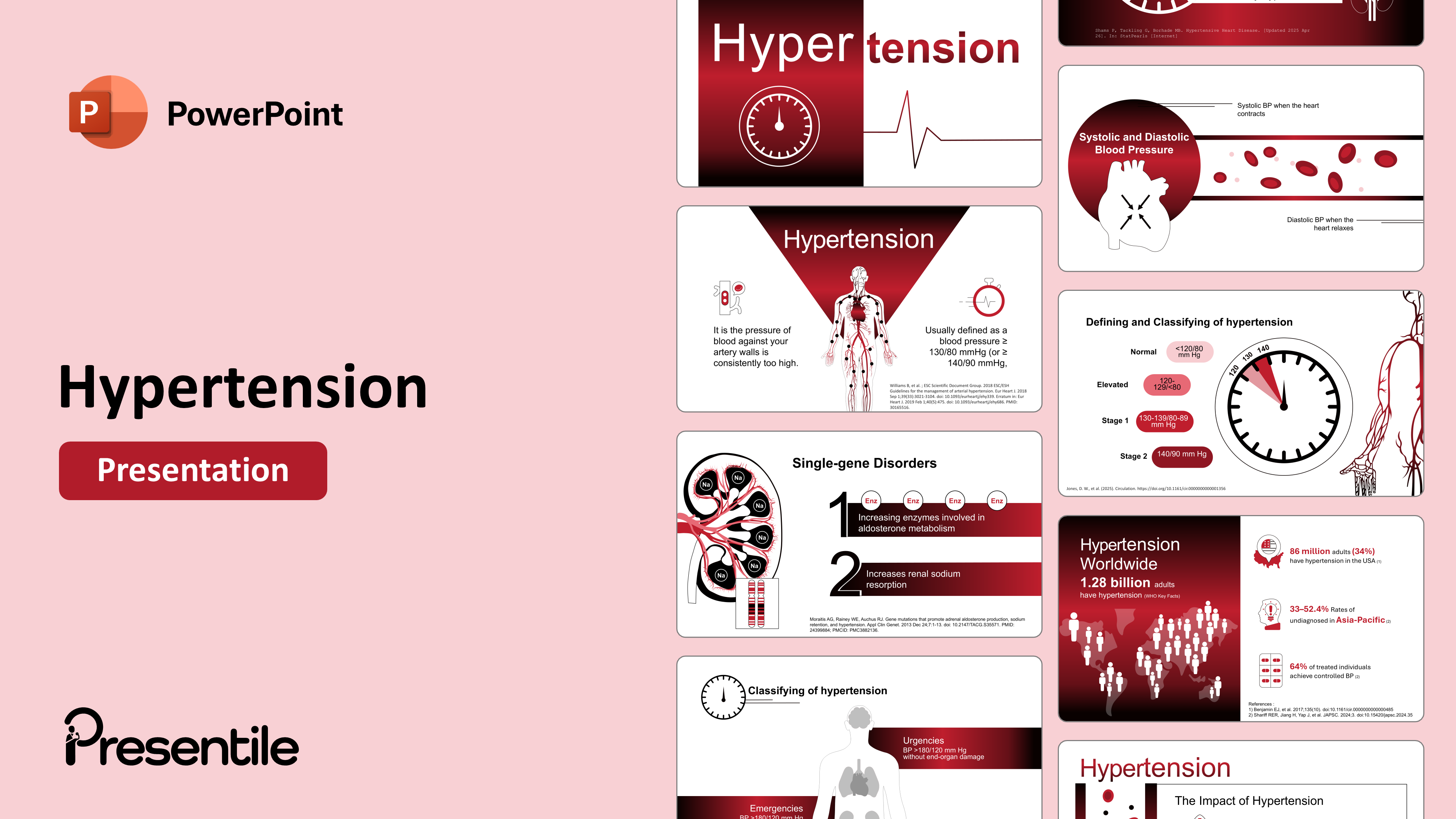
Content of
Hypertension Presentation
Slide 1: Hypertension (Title Slide)
.PNG)
This visually dramatic slide introduces a critical presentation on Hypertension (High Blood Pressure). The design uses a split color scheme with strong visual metaphors.
- Title: Hypertension is prominently displayed, split across the two background colors.
- Visual Metaphors:
- Left (Red/Black Gradient): Features the word "Hyper" on a dark red gradient, suggesting danger or high pressure, along with a dial/gauge icon that visually represents blood pressure measurement.
- Right (White): Features the word "tension" on a white background, balanced by an ECG trace that drops sharply, linking high pressure to cardiovascular risk.
Slide 2: Hypertension Worldwide (Epidemiology)
.PNG)
This slide provides global and regional statistics on the prevalence, diagnosis, and treatment of hypertension. The strong red background and world map motif reinforce the scale of the public health crisis.
- Global Prevalence: 1.28 billion adults have hypertension (based on WHO Key Facts). This sets the massive scope of the problem.
- USA Prevalence: 86 million adults (34%) have hypertension in the USA. This offers a specific national data point for context.
- Undiagnosed Rates: 33–52.4% Rates of undiagnosed in Asia-Pacific. This highlights the significant challenge of detection and awareness.
- Treatment Control: Only 64% of treated individuals achieve controlled BP. This points out the gap in effective management even among those receiving care.
Slide 3: The Impact of Hypertension
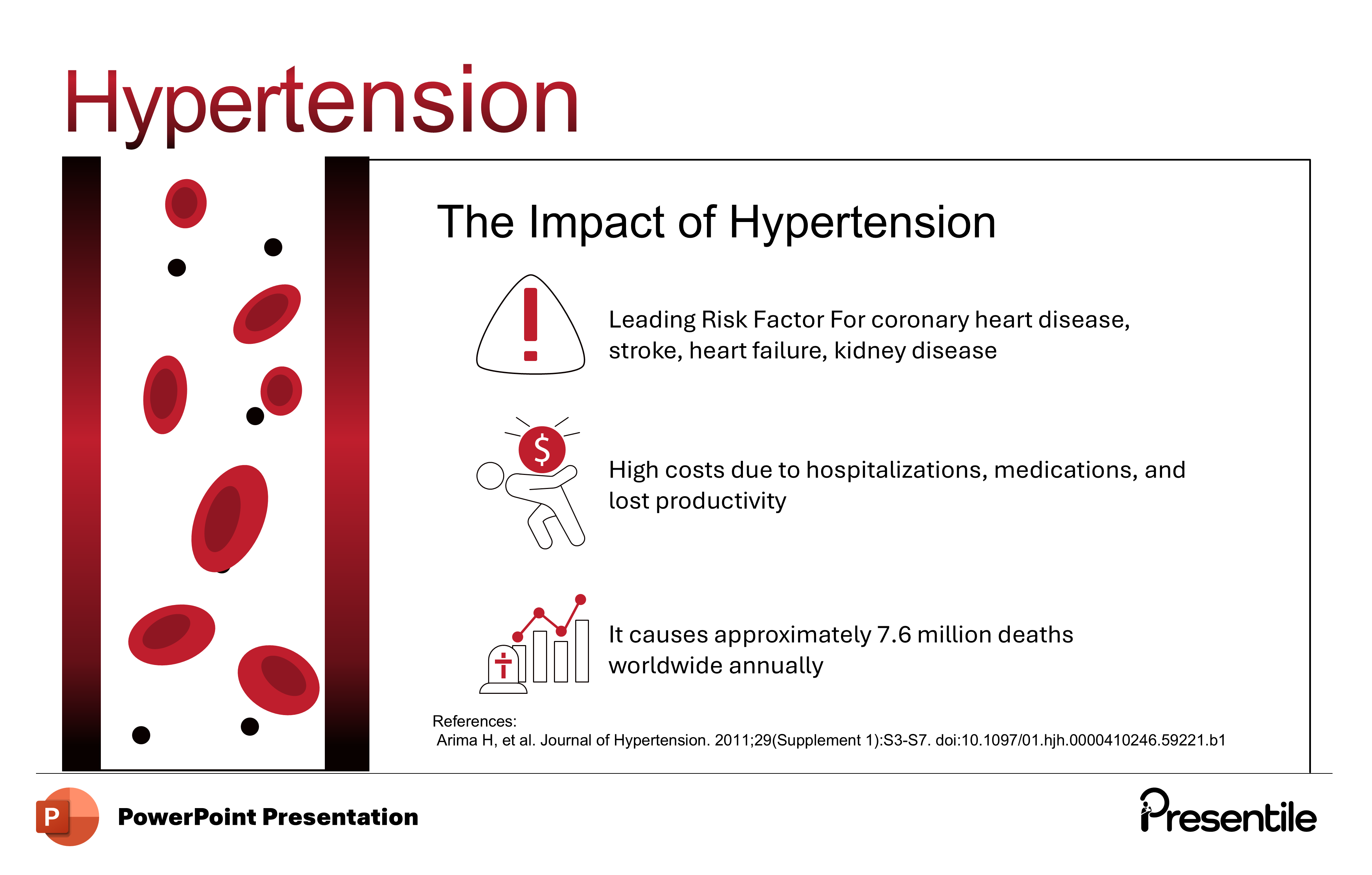
This slide details the severity of hypertension by outlining its major consequences on health and society. The visual on the left shows blood flow through a narrowed, diseased vessel, while the bullet points emphasize the clinical and economic cost.
- Leading Risk Factor: Hypertension is the Leading Risk Factor for several major cardiovascular and renal diseases, including coronary heart disease, stroke, heart failure, and kidney disease. This links back to your previous presentation on Stroke, where hypertension was a major cause.
- Economic Cost: It leads to High costs due to hospitalizations, medications, and lost productivity. This highlights the societal burden.
- Global Mortality: It causes approximately 7.6 million deaths worldwide annually. This emphasizes the lethal nature of uncontrolled blood pressure.
Slide 4: Definition and Classification of Hypertension
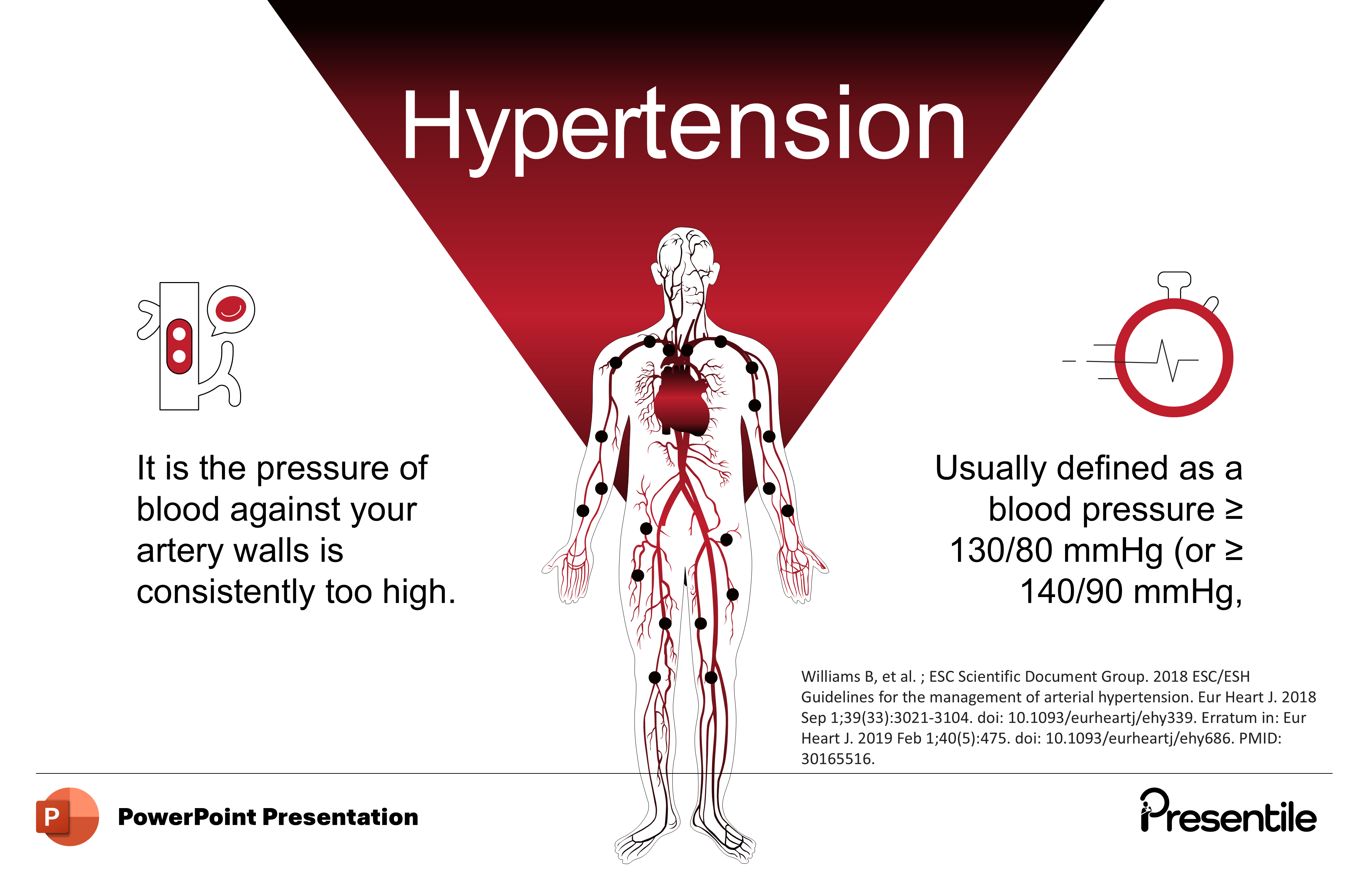
This slide provides the core medical definition of hypertension and introduces the blood pressure thresholds used for diagnosis. The central anatomical graphic of the circulatory system grounds the definition in the body.
- Definition: Hypertension is when the pressure of blood against your artery walls is consistently too high.
- Diagnostic Threshold: It is usually defined as a blood pressure ≥130/80 mmHg (or ≥140/90 mmHg). The dual classification reflects different guidelines or clinical contexts, which is an important point for the audience.
Slide 5: Systolic and Diastolic Blood Pressure
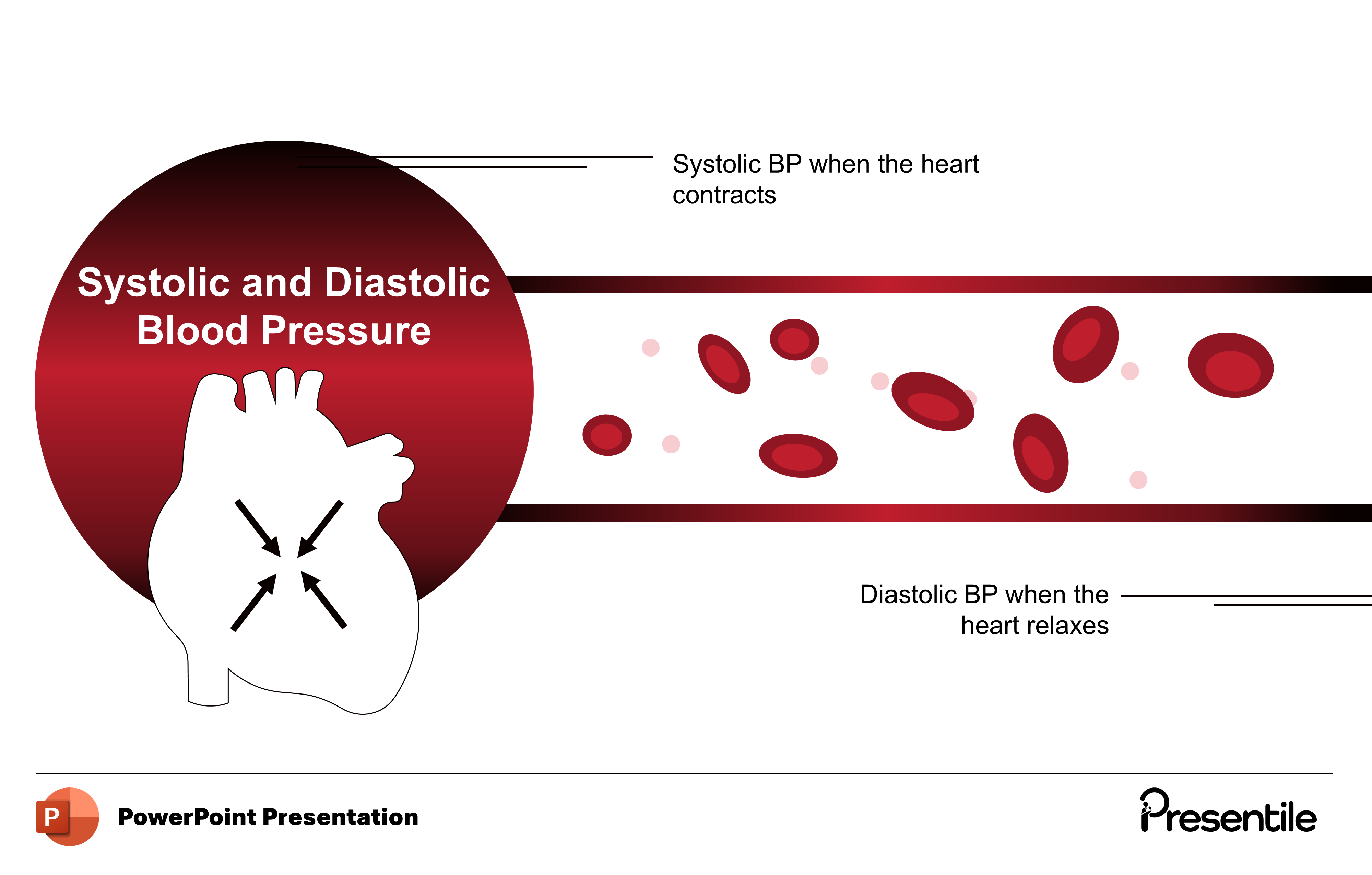
This slide explains the two numbers that constitute a blood pressure reading and the mechanical action of the heart associated with each. The visual shows a heart next to a blood vessel to illustrate the concepts.
- Systolic BP: This is the pressure recorded when the heart contracts. It represents the peak pressure exerted on the artery walls during the heartbeat.
- Diastolic BP: This is the pressure recorded when the heart relaxes. It represents the lowest pressure in the arteries between heartbeats.
- Visual: The diagram shows blood flow through a vessel, connecting the heart's action (contraction and relaxation) to the pressure within the artery.
Slide 6: Defining and Classifying of Hypertension

This crucial slide moves beyond the definition to detail the current clinical stages of blood pressure, from normal to Stage 2 Hypertension. This classification is essential for determining treatment paths.
- Visual: The slide uses an illustrated gauge to visually represent the categories, corresponding to colored bars on the left.
- Classification Levels:
- Normal: Defined as <120/80 mmHg.
- Elevated: Defined as 120–129/<80 mmHg. This is the precursor stage, often managed with lifestyle changes.
- Stage 1: Defined as 130–139/80–89 mmHg.
- Stage 2: Defined as ≥140/90 mmHg. This is the most severe and often requires aggressive pharmacological treatment.
Slide 7: Classifying of Hypertension (Emergencies and Urgencies)
.PNG)
This slide introduces the clinically distinct categories of severely elevated blood pressure: Hypertensive Emergencies and Hypertensive Urgencies. This is vital for clinical triage and management.
- Emergencies: Defined as blood pressure BP>180/120 mmHg with end-organ damage. These situations require immediate, controlled blood pressure reduction in an intensive care setting.
- Urgencies: Defined as blood pressure BP>180/120 mmHg without end-organ damage. While still severe, these can usually be managed with blood pressure reduction over a period of hours in a less intensive setting.
Slide 8: Pathophysiology (Primary and Secondary Hypertension)
.PNG)
This slide introduces the two main etiological classifications of hypertension, which dictate the diagnostic and treatment approach. The visual uses the pressure gauge and icons of specific organs to illustrate the cause.
- Primary Hypertension: This is the most common form, where there is no single identifiable cause. It is usually the result of a combination of genetic and lifestyle factors.
- The icon featuring the arterial system often represents the systemic resistance or arterial stiffness that underlies Primary Hypertension.
- Secondary Hypertension: This form has an underlying, correctable cause.
- The icon featuring the kidneys suggests that renal disease (e.g., renovascular disease) is a common cause of Secondary Hypertension.
Slide 9: Primary Hypertension (Risk Factors)
.PNG)
This slide details the four major, non-modifiable and modifiable risk factors that contribute to the development of Primary Hypertension. The visual uses clear icons to represent each factor.
- Obesity: Being overweight is a significant modifiable risk factor.
- Salty diet: High salt intake contributes to fluid retention and higher blood pressure (a modifiable factor).
- Smoking: Tobacco use damages blood vessels and is a major modifiable risk factor.
- Old Age: Increasing age is a non-modifiable risk factor, as arteries naturally stiffen over time.
Slide 10: Secondary Hypertension (Causes)
.PNG)
This slide details five specific underlying causes that can lead to Secondary Hypertension. Identifying these is critical because treating the root cause can normalize blood pressure. The visual highlights the kidneys and associated vessels.
The major causes listed are:
- Primary renal disease: Kidney disease is a very common cause of high blood pressure.
- Renal artery stenosis: Narrowing of the arteries that carry blood to the kidneys can trigger a strong blood pressure response.
- Pheochromocytoma: A tumor in the adrenal gland that secretes excess adrenaline-like hormones, causing severe hypertension.
- Cushing syndrome: A condition of excessive cortisol, which can also raise blood pressure.
- Renin-producing tumors: Tumors that secrete renin, a hormone central to blood pressure regulation.
Slide 11: Single-gene Disorders (Genetic Pathophysiology)
.PNG)
This slide details specific genetic mechanisms that can cause hypertension, often by disrupting the body's balance of salt and water. It highlights the role of the kidney and genetic mutations.
- Mechanism 1: Increasing enzymes involved in aldosterone metabolism. Aldosterone is a hormone that promotes sodium and water retention, and increased enzyme activity leads to more aldosterone and higher blood pressure.
- Mechanism 2: Increases renal sodium resorption. This means the kidneys hold onto more sodium, which in turn causes the body to retain more water, leading to increased blood volume and hypertension.
- Visual: The diagram shows the kidney's nephron structure actively reabsorbing sodium (Na+), linking the genetic mutation (represented by the chromosome icon) to the physiological effect in the kidney.
Slide 12: Benign Hypertension
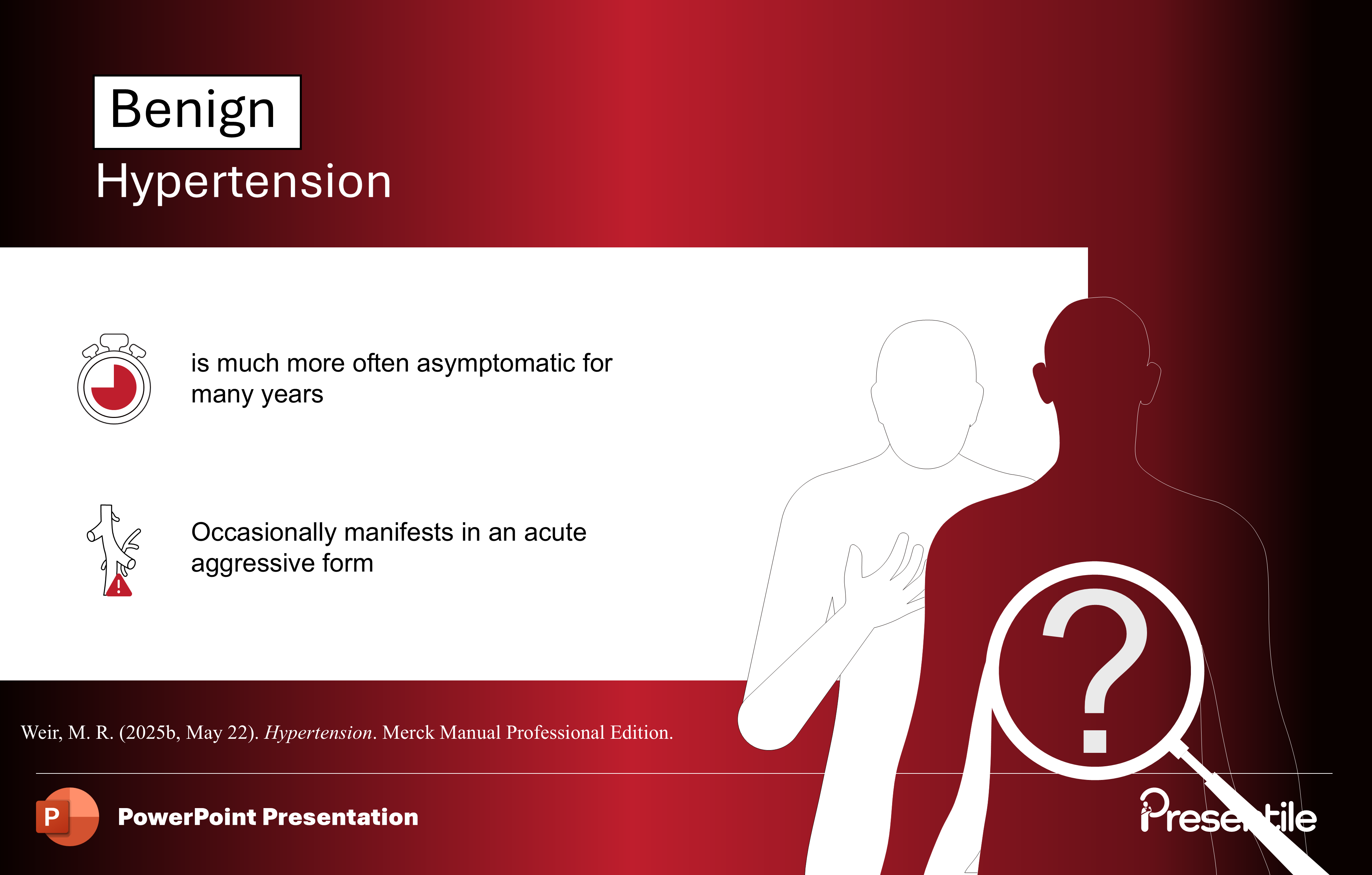
This slide defines the term "Benign Hypertension" and highlights its typical clinical course and occasional acute presentation. This classification is important for patient expectations and management.
- Clinical Course: Benign Hypertension is much more often asymptomatic for many years. This is why hypertension is often called the "Silent Killer."
- Acute Manifestation: It occasionally manifests in an acute aggressive form. This refers to a transition into a hypertensive crisis (urgency or emergency), as previously detailed on Slide 7.
- Visual: The diagram of the silhouette with a question mark over the chest reinforces the asymptomatic nature of the condition, while the blood vessel with a warning sign indicates the occasional aggressive acute form
Slide 13: Hypertension Risks

This slide highlights two major structural complications of chronic, uncontrolled hypertension on key parts of the circulatory and renal systems. The visual emphasizes the heart and kidneys as target organs.
- Aortic dissection: This is a life-threatening condition where high pressure causes a tear in the inner layer of the aorta, the body's main artery.
- Renal failure: Chronic high pressure damages the small blood vessels in the kidneys, progressively impairing their filtering function and leading to kidney failure.
- Visual: The diagram on the right explicitly shows the narrowing of a vessel (suggesting damage/atherosclerosis) and the layered structure of the aorta, illustrating where dissection can occur.
Slide 14: Hypertension Risks (Cerebral and Coronary)
.PNG)
This slide details the major long-term damage caused by hypertension to the brain and coronary arteries, linking high blood pressure to stroke, dementia, and heart disease. The visual highlights the brain, heart, and kidneys as target organs.
- Ischemic stroke: High blood pressure damages the vessels, increasing the risk of blockages that lead to stroke. This connects back to the previous presentation on stroke.
- Multi-infarct dementia: Repeated small strokes (infarcts) due to hypertension can lead to progressive cognitive decline.
- Atherosclerotic coronary heart disease: Chronic high pressure accelerates the hardening and narrowing of the arteries that supply the heart, leading to heart attacks and other coronary events.
Slide 15: Malignant Hypertension

This slide details Malignant Hypertension, a form of accelerated, severe hypertension that is highly dangerous and carries a very poor prognosis if untreated. It highlights the specific clinical damage and mortality risk.
- Definition/Visual: Malignant Hypertension is a severe, systemic cardiovascular disease. The anatomical visual reinforces the widespread damage it causes across the body.
- Specific Consequences:
- Renal failure: Severe pressure damages the kidneys rapidly.
- Retinal hemorrhages: Bleeding in the eyes is a classic sign of this accelerated damage.
- Prognosis: If left untreated, it has a stark prognosis of Death within two years.
Slide 16: Management of Hypertension
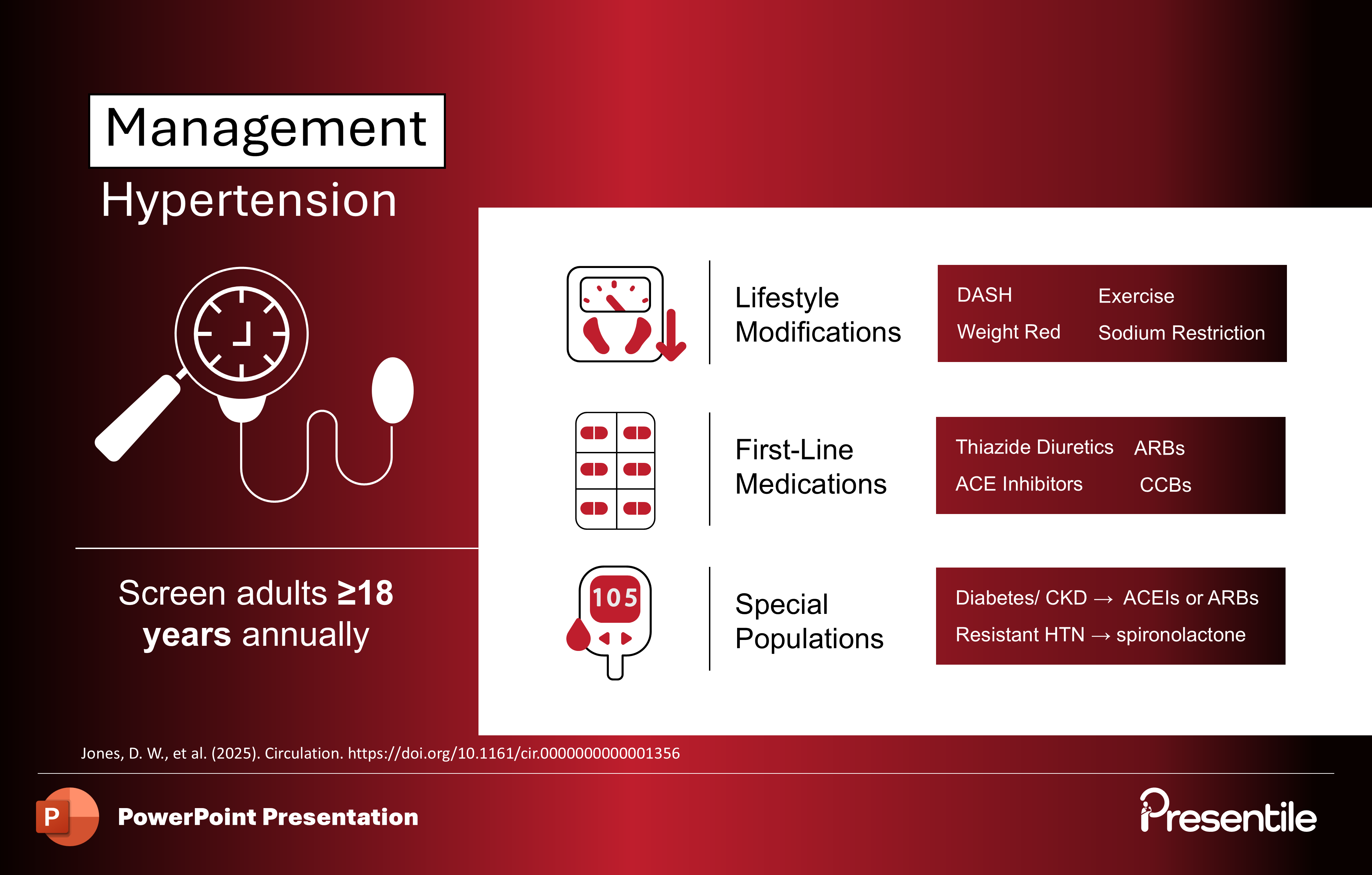
This slide provides a comprehensive overview of the three main pillars of hypertension management: screening, lifestyle modifications, and pharmacological treatments. This is the crucial, actionable final content slide.
- It recommends screening adults ≥18 years annually. This emphasizes the importance of routine blood pressure checks.
- Lifestyle Modifications: These include a comprehensive approach:
- DASH (Dietary Approaches to Stop Hypertension): A specialized diet plan.
- Exercise
- Weight Reduction
- Sodium Restriction
- First-Line Medications: Key classes of drugs used for initial treatment:
- Thiazide Diuretics
- ARBs (Angiotensin II Receptor Blockers)
- ACE Inhibitors (Angiotensin-Converting Enzyme Inhibitors)
- CCBs (Calcium Channel Blockers)
- Special Populations: The slide addresses tailored therapy for specific patient groups:
- Diabetes/CKD (Chronic Kidney Disease): ACEIs or ARBs are preferred.
- Resistant HTN: Spironolactone is a common addition.
Slide 17: Innovations and Future Directions

This slide provides an exciting forward-looking perspective on how the diagnosis and treatment of hypertension are evolving through technology and genetic understanding. The content is divided into three major areas of innovation.
- Personalized Medicine: Focuses on genetic and molecular profiling for tailored treatments. This suggests moving away from one-size-fits-all therapy toward treatments based on a patient's unique biological makeup.
- Digital Health: This includes the use of wearables for real-time BP monitoring and adherence. This leverages technology for continuous patient data collection and improved patient compliance.
- Novel Therapies: This covers advanced medical treatments:
- Immunomodulators
- Renal denervation
- SGLT2 inhibitors (a class of drug originally for diabetes now showing benefit in cardiovascular and renal disease).
Slide 18: Thank You (Conclusion)
.PNG)
This slide serves as the concise and professional closing to your 18-slide presentation on Hypertension.
The design reinforces the core topic:
- Visual: The slide features the blood pressure gauge icon used throughout the presentation against the striking red and black background.
- Message: The text "Thank you" formally concludes the content and signals the end of the presentation.
Features of
Hypertension Presentation
- Fully editable in PowerPoint
- All graphics are in vector format
- Medically Referenced information and data
 Slides count:
Slides count: Compatible with:Microsoft PowerPoint
Compatible with:Microsoft PowerPoint File type:PPTX
File type:PPTX Dimensions:16:9
Dimensions:16:9




